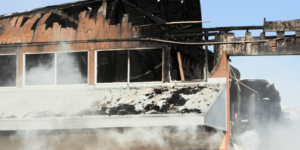
Mold thrives in moist environments and has been around for millions of years. Left to grow, mold spores that get into the air are a potential health hazard to you and your family and can even threaten to damage the structure of your home.
Dark mold is often called “black mold,” though mold doesn’t have to be dark to be dangerous. Mold will typically thrive in humid conditions. While the presence of mold can look nasty, it is the undetected airborne toxins that pose significant dangers.
Senior citizens and those susceptible to respiratory complications are among the high-risk groups for mold health risks. Mold causes some people to show watery eyes, itching, throat irritation, coughing, or runny noses. More severe consequences include:
- Nausea
-
- Fatigue
-
- Sinus infection
-
- Difficulty breathing
-
- Headaches and dizziness
-
- Impaired attention span
Signs Your Home Needs Professional Help
When you see or smell mold forming in your home, the problem already poses potential health problems for you and your family. Regular home inspections by experts in mold remediation can stop mold issues before they become hazardous.
The following are some of the signs to look for throughout your home.
Visible Signs
Outward visible signs of mold typically indicate a significant problem in your home. Fuzzy fungus spreading on the surfaces in your home means a rapidly growing mold issue. Sections of uneven flooring and paint bubbling on walls can also point to mold growth.
Squishy floorboards on your hardwood flooring often indicate a developing mold problem. If you can reach the subfloor through your basement or crawlspaces, you can check for conditions conducive to mold growth. Even if you have to lift a board to inspect underneath, it will be worth the effort if mold infestation occurs.
Mold Smells
While you may not always be able to see or recognize mold visibly, the distinct odor it creates may give it away. If your home begins to smell musty, stale, or damp, the chances are good that you have mold growing somewhere in your home. Some people compare mold smells to wet socks or rotten wood.
It’s also possible for you to get used to the moldy smell to where you don’t notice it anymore. Spend a few hours out of the house or ask a friend to walk through your home to know if the smell is gone.
Hidden Mold
Mold loves to hide in those secret spots in your home that are warm, dark, and damp. Just because you figured out you have a mold issue doesn’t mean you figured out where that issue is. Common hidden areas where mold is most likely to grow include:
-
- Bathrooms: Mold growing along the grout of your bathroom tile is usually quickly noticed. However, bathrooms are popular for mold growth in less obvious places like plumbing, under flooring, and under the bathtub. Traditional shower curtains are also easy for mold to grow on. Improper ventilation in the bathroom is a leading cause of mold growth too.
-
- Kitchens: Your kitchen has many things that can produce moisture and leave water residue behind. Mold will flourish around your refrigerator, freezer, ice dispensers, and other areas where water can collect.
-
- Laundry rooms: Leaky washing machines can cause water to pool and encourage mold to grow. Leaving your washing machine open for long periods will help it stay dry.
-
- Bedrooms: Poorly sealed windows in the bedrooms can provide enough moisture for mold to grow. Mattresses can also attract mold if you have not flipped them over in a while.
-
- Attics, Basements, and Vents: A leaky roof or ventilation system will collect enough moisture for mold to grow and prosper, especially in low-traffic areas like the attic or basement. Regular checks of these areas will help prevent the spread of mold in these dark, moist areas of the house.
Preventing Mold Growth
The best way to deal with a mold problem is to not have one in the first place. You can’t always stop a complication like this from happening, but there are several things you can do to give yourself the best chance to stay mold-free.
After hard rain or flooding, that finds a way inside is a prime time for mold to find the moisture needed to grow. Ensuring all areas of the home are thoroughly clean and dry after a storm will help deter mold growth in your home.
Some tactics to help prevent mold growth in your home include:
-
- Fix leaky roofs, windows, and pipes
-
- Install eco-friendly windows and doors that provide tight seals.
-
- Control humidity levels in the house to reduce moisture in the air
-
- Thorough regular cleaning and drying of susceptible, particularly after rains and flooding
-
- Ventilate bathroom, laundry, and cooking areas
-
- Mold inhibitors can be added to paints.
-
- Utilize commercial mold-killing products when cleaning the bathrooms.
Mold Remediation Austin, TX
Whenever you have mold issues, call All Nation Restoration. We’re ready to help you get mold removed and done away with. Estimates are free, so there’s no reason to wait.







